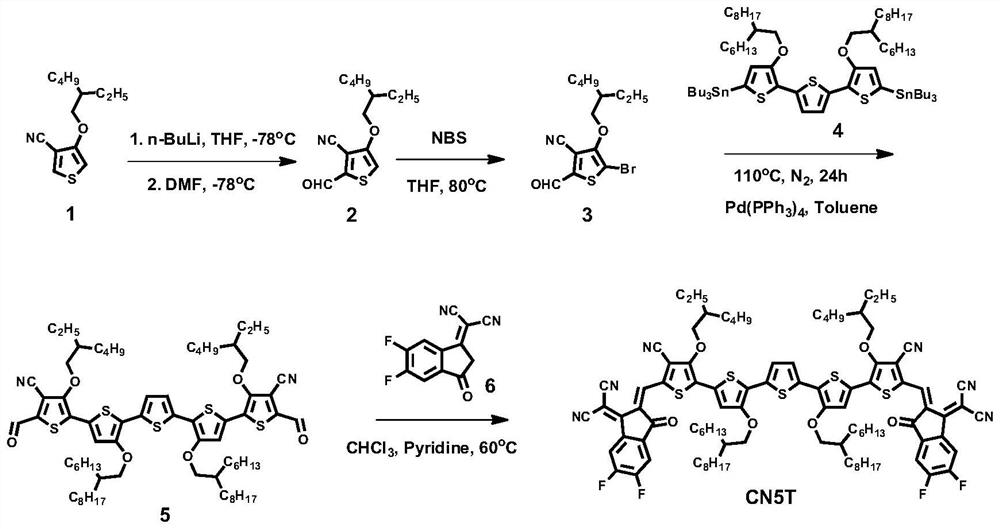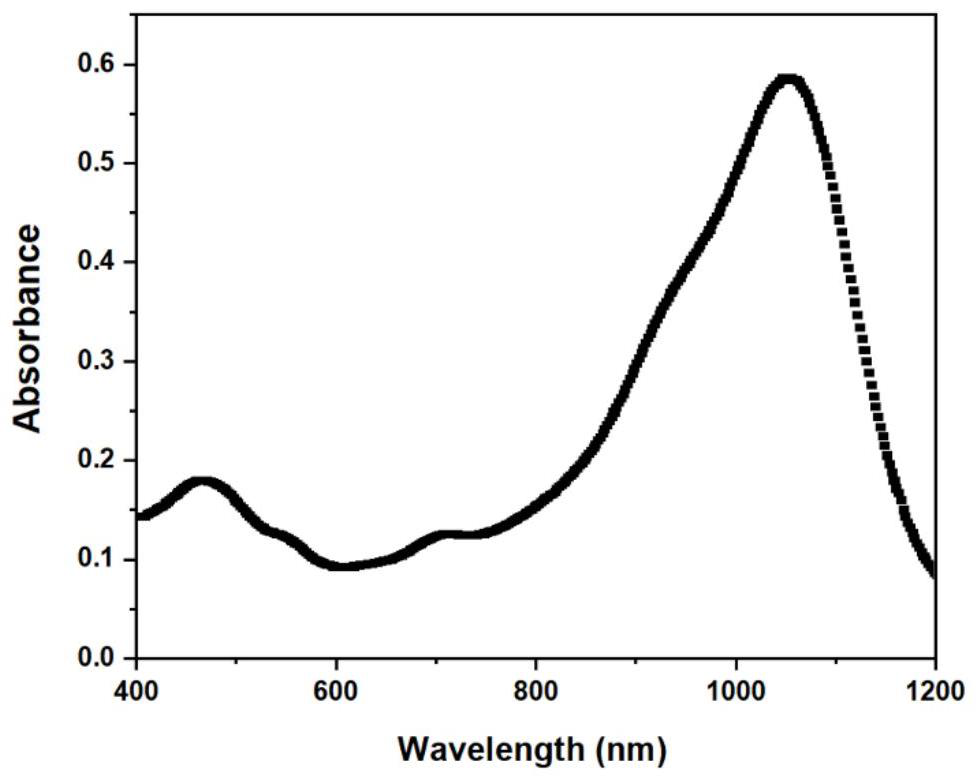Near-infrared organic photoelectric molecular material based on 3-alkoxy-4-cyano thiophene
A cyanothiophene, molecular material technology, applied in photovoltaic power generation, organic chemistry, silicon organic compounds, etc., can solve the problems of small absorption spectrum, lack of organic photoelectric materials, etc., to reduce the molecular band gap, enhance the charge transfer effect, The effect of good solubility
- Summary
- Abstract
- Description
- Claims
- Application Information
AI Technical Summary
Problems solved by technology
Method used
Image
Examples
Embodiment 1
[0044] The synthesis of embodiment 1, CN5T
[0045] chemical reaction flow chart figure 1 Shown, concrete reaction steps and reaction conditions are as follows:
[0046] Compound 2 ( figure 1 The preparation of the compound marked as 2) in: under inert atmosphere, compound 1 ( figure 1The solution of the compound marked as 1) (2.37g, 10mmol) in anhydrous tetrahydrofuran (100mL) was lowered to -78°C, and a solution of n-butyl lithium (2.4M, 4.17mL) was slowly added dropwise, and the reaction was stirred for 1h. Then dry N,N-dimethylformamide (1.46g, 20mmol) was added slowly at -78°C, and the reaction was stirred for 1h. The reaction solution was raised to room temperature to continue the reaction for 3 h, and then 5 mL of water was added to quench the reaction. The reaction solution was extracted with dichloromethane, washed three times with water, and dried over anhydrous magnesium sulfate. The organic phase was rotovapped to remove the solvent, using petroleum ether:dich...
Embodiment 2
[0050] The synthesis of embodiment 2, CN4T
[0051] chemical reaction flow chart figure 2 The specific reaction steps and reaction conditions are as follows:
[0052] Compound 8 ( figure 2 The preparation of the compound marked as 8 in the middle: under inert atmosphere, compound 3 (1.47g, 4.26mmol) and compound 7 ( figure 2 In the solution of the compound marked as 7) (1.39g, 1.42mmol) in anhydrous toluene (30mL), add Pd(PPh 3 ) 4 (116 mg, 0.1 mmol). The whole reaction system was heated to 110°C and stirred for 48 hours. After the reaction solution was cooled, methanol was added for precipitation, centrifuged, and the solid part was dissolved with chloroform, washed three times with water, and dried over anhydrous magnesium sulfate. The organic phase was rotary evaporated to remove the solvent, using petroleum ether:dichloromethane (4:1) as eluent, separated by silica gel column chromatography, and the purple solid product-compound 8 (0.91g, 69%) was obtained after r...
Embodiment 3
[0054] Example 3 Determination of the UV-visible-near-infrared absorption spectrum of the organic optoelectronic molecule CN5T in a thin film state: the organic optoelectronic molecule CN5T was dissolved in chloroform to prepare a solution with a concentration of 20 mg / mL, and a part of the solution was spin-coated on a quartz plate to form a film. The absorption spectrum measured in the thin film state is as follows image 3 As shown, the absorption spectrum exceeds 1.2 μm.
[0055] It can be seen from the above examples that the present invention applies the 3-alkoxy-4-cyanothiophene structure to the construction of near-infrared organic photoreceptor molecules, wherein the alkoxy group forms a strong electron-donating conjugation effect with the central unit, and the cyano group Form a strong electron-pulling conjugation effect with the terminal unit, which can simultaneously improve the electron-donating ability of the former and the electron-accepting ability of the latt...
PUM
 Login to View More
Login to View More Abstract
Description
Claims
Application Information
 Login to View More
Login to View More - R&D
- Intellectual Property
- Life Sciences
- Materials
- Tech Scout
- Unparalleled Data Quality
- Higher Quality Content
- 60% Fewer Hallucinations
Browse by: Latest US Patents, China's latest patents, Technical Efficacy Thesaurus, Application Domain, Technology Topic, Popular Technical Reports.
© 2025 PatSnap. All rights reserved.Legal|Privacy policy|Modern Slavery Act Transparency Statement|Sitemap|About US| Contact US: help@patsnap.com



